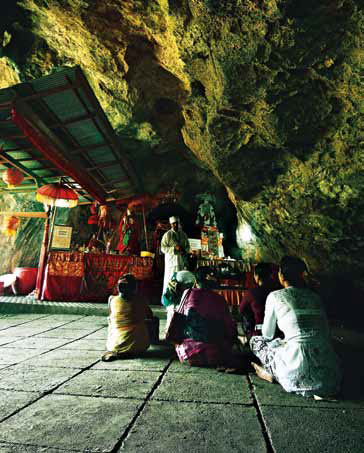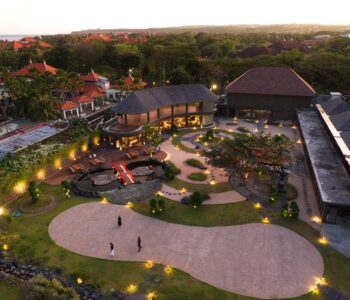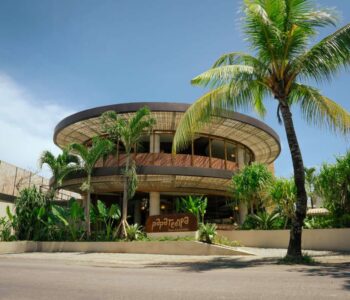TAKEN FROM REAL BALI BOOK Given the island’s unique religious and cultural dimensions, it’s no surprise that Bali’s places of worship are so plentiful and diverse. We’ve gathered together a collection of seven of Bali’s most interesting and mystical puras (temples).PULAKI This temple is located in Pemuteran village, the eastern part of Buleleng regency. During rainy season, the dry brown mounds behind the temple transform into sparkling green hills. Black and white stone make up the temple walls, as if the hills themselves
PULAKI
This temple is located in Pemuteran village, the eastern part of Buleleng regency. During rainy season, the dry brown mounds behind the temple transform into sparkling green hills. Black and white stone make up the temple walls, as if the hills themselves
TAKEN FROM REAL BALI BOOK
Given the island’s unique religious and cultural dimensions, it’s no surprise that Bali’s places of worship are so plentiful and diverse. We’ve gathered together a collection of seven of Bali’s most interesting and mystical puras (temples).
PULAKI

This temple is located in Pemuteran village, the eastern part of Buleleng regency. During rainy season, the dry brown mounds behind the temple transform into sparkling green hills. Black and white stone make up the temple walls, as if the hills themselves were being carved to create it. Monkeys roam around inside and outside the temple, disrupting the people bringing offerings.
Nevertheless, a visit Pulaki Temple is a spectacular experience. Upon entering the temple, you will find the mid-court. From here the beguiling blue of the Javanese Sea can be seen clearly with beautiful green hills to the right and left. There are more stairs to climb if you wish to enter the main court where people place their offerings and pray. Always alive with activity, the main court is the favourite hangout spot for mischievous monkeys awaiting their next chance to nab some fruit. Despite the noise of the monkeys, people still manage to concentrate fully on their prayers; they must be used to it!
MELANTING PEMUTERAN

The tale of Melanting Temple is still being told to this day. The temple was built to commemorate the visit of the Javanese Hindu Priest, Danghyang Nirartha. It is believed to be the site of his eldest daughter’s transformation into a spirit when she cursed her tormenters who subsequently turned into spirits too. Those spirits are now the guardians of the jungle in that particular area, while Ida Swabawa is praised as a holy spirit.
The temple is nestled in the middle of a jungle in the foothills of Pemuteran, North Bali. To reach the area, take a narrow turn off from the Pemuteran main road, you will pass through a wooded area and some local houses. Nowadays, a huge parking lot and some warung food stalls are available in the temple area. The once wild jungle has become more civilized with lights illuminating the roadsides and parking lot.
GUNUNG KAWI

Two kilometers south of Tampaksiring there is a magnificent site with an intriguing legend, where the Balinese Hindus come to pray. A temple stands amidst a green valley. The temple is named Pura Gunung Kawi. A “gunung” is a high place or a mountain and “Kawi” refers to a carved Candi (temple).
A long, steep, stone stairway leads down to this ancient site. When the rain falls the stairs can be very slippery. When you walk down the stairs a breathtaking view of paddy terraces greets you. The sound of the nearby river fills your ears. Beauty surrounds you and you can feel the sacredness of the site as the atmosphere is so calm and there aren’t many people around, despite the numerous souvenir shops neatly lining both sides of the stairs.
PUNCAK PENULISAN

When taking a road trip from Kintamani to Singaraja, your eyes are presented with truly fantastic scenery along the way. However, on that same journey on the right hand side of the road, about 3km out of Kintamani, there is a steep set of stairs that disappear up a hill. It is the stairway to Pura Puncak Penulisan, an ancient temple at the top of the hill.
The temple is 1,745m above sea level so you can imagine the hard walk to reach the main shrine. According to an ancient manuscript, Bukit Penulisan (bukit means hill) is the hill that segregates the mountain range that stretches from west to east; as if dividing Bali into two parts. The temple was built in the 9th century and was originally named Pura Tegeh Koripan.
BATU KARU

Arriving in the centre of Tabanan regency, follow the smooth asphalt road to Penebel village, known as the rice bowl of Bali. You will know when you are already in the village when a huge expanse of rice fields surround you. From here, continue on the winding road to Wongaya Gede village until the road ends and you will find yourself at Pura Luhur Batukaru.
Pura Luhur Batukaru is a temple nestled at the southern foot of Mount Batukaru. Mpu Kuturan, a priest from Java, built it in the 11th century. Some say that Mpu Kuturan built this temple to remind people to keep the existence of the soul, ocean, forest, lake, earth, and the individual in balance. The site was used by people as their place of meditation, to gain spiritual consciousness and to find balance in their lives.
GOA GIRI PUTRI

In the prehistoric era caves were the sanctuary not only of animals but also of humans. As people started to believe in the existence of powers beyond human imagination, the powers of the universe or Gods, caves then became a place for worship and meditation. In Bali, there are many caves, their uses and functions have changed with time but the sanctity of these caves will always remain. One of Bali’s sacred caves can be found in Nusa Penida and is called Goa Giri Putri.
Goa means cave, Giri means mountain and Putri means female, so the cave’s name, Goa Giri Putri was given as to honor the female Hindu God who resides in the cave beneath the mountain. There are 13 shrines inside the cave, all built with different architectural designs and materials determined by the different sacred visions given to holy men. Strangely, the cave does not have a foul odor, which comes as a surprise considering that there are many bats that call this cave home. Another surprising feature of this cave is that it has a second floor. This second floor is considered more sacred and is only accessible to people wishing to pray or meditate. There is a shrine located on the wide space on the second floor, which can only be accessed through stairs from the middle of the first floor.
GOA LAWAH

The temple at Goa Lawah, meaning bat cave, is located on the border of Klungkung regency and Karangasem regency. You will definitely pass this temple if you are making your way to Candidasa. Directly opposite is a black sand beach with pristine waters, from which you can see Nusa Penida on the horizon. The temple is one of the island’s nine special Sad Khayangan Temples. Rsi Markandya, a priest from Java, found this holy place. This sacred destination is designated to honour Dewa Maheswara, the God that rules the southeast.
Inside the innermost compound stands an old shrine and of course the dark bat cave. The old shrine is dedicated to Shiva and has been worshiped since around 1000AD. There is also a bale, decorated by the painting of Naga Basuki, the legendary giant snake believed to be the caretaker of earth’s equilibrium. It is said that the prince of Mengwi once hid in this cave for protection. He followed the cave’s tunnel system to where it ends at Pura Besakih, located on the slopes of Gunung Agung. However, due to the number of bats that inhabit the cave and because of the legends of Naga Basuki, no attempt to venture to Pura Bekasih has been made since.









